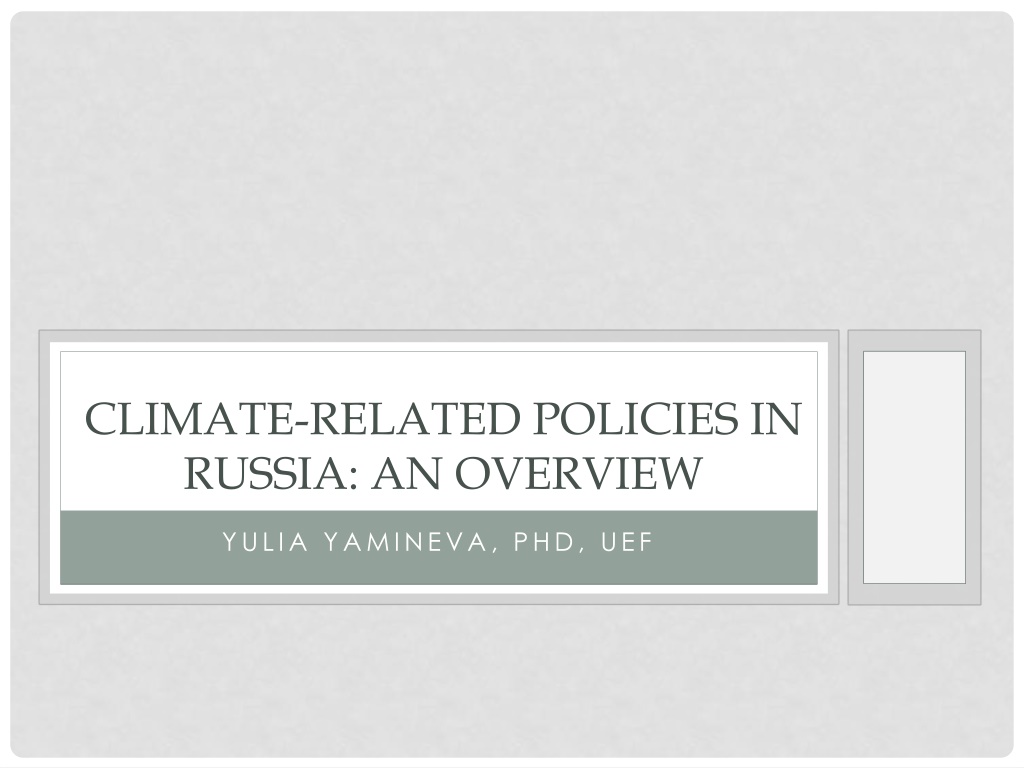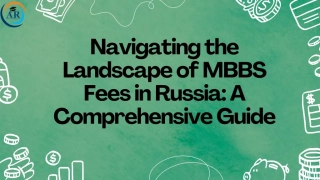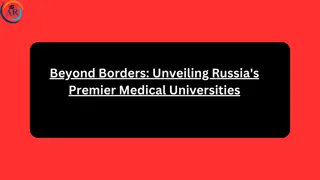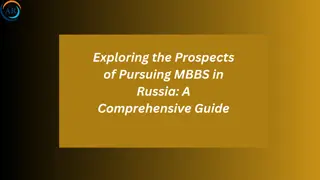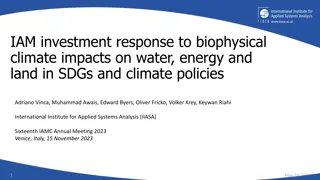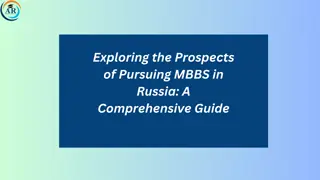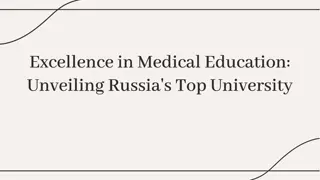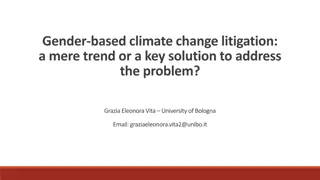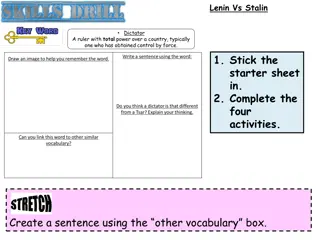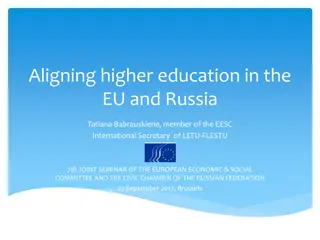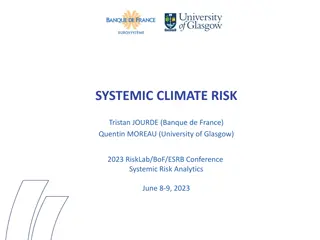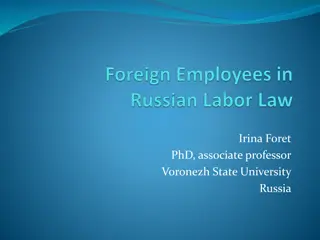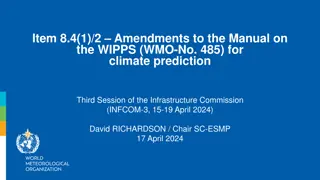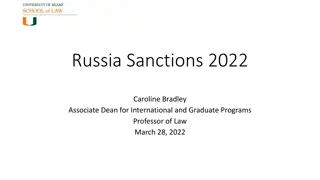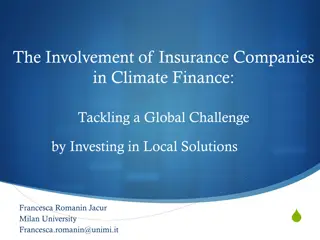Russia's Climate Policies: An Overview
Russia's climate-related policies encompass ratification of the UN Framework Convention on Climate Change and the Kyoto Protocol, with a focus on emission reduction goals and energy sector initiatives. Despite being a significant emitter, Russia has taken steps towards energy efficiency and renewable energy development, aiming to reduce greenhouse gas emissions.
Download Presentation

Please find below an Image/Link to download the presentation.
The content on the website is provided AS IS for your information and personal use only. It may not be sold, licensed, or shared on other websites without obtaining consent from the author.If you encounter any issues during the download, it is possible that the publisher has removed the file from their server.
You are allowed to download the files provided on this website for personal or commercial use, subject to the condition that they are used lawfully. All files are the property of their respective owners.
The content on the website is provided AS IS for your information and personal use only. It may not be sold, licensed, or shared on other websites without obtaining consent from the author.
E N D
Presentation Transcript
CLIMATE-RELATED POLICIES IN RUSSIA: AN OVERVIEW YULIA YAMINEVA, PHD, UEF
STRUCTURE Russia and UN Framework Convention on Climate Change, Kyoto Protocol Climate Doctrine, national emission reduction goal Climate-related policies in the energy sector: energy efficiency, renewable energy, reducing emissions from gas flaring Kyoto Protocol mechanisms Russia s position on a future UN agreement on climate change Perspectives on EU-Russia climate cooperation
RUSSIA AND UNFCCC Ratified the Convention in 1994 Annex I Party: limiting GHGs, reporting But economy in transition : a certain degree of flexibility and no financial commitments Ratified Kyoto Protocol in 2004 Kyoto-1 for 2008-2012: not exceeding emissions of 1990 In 1997 emissions were 37% lower than in 1990 holder of excess carbon credits
RUSSIAS GHG EMISSIONS In 2013, emissions were at 70% from 1990 levels (Ministry for Economic Development) Fourth largest emitter in the world but role of sinks Energy sector accounts for 82.4% of total emissions One of the most carbon intensive economies. Energy efficiency potential is about 45% (World Bank 2008)
EVOLUTION OF CLIMATE POLICY No national climate policy and legislation up to 2009 Climate Doctrine 2009 (anthropogenic climate change). Mitigation policies: increasing energy efficiency in all sectors of the economy; developing renewables and alternative sources of energy; reducing market failures and implementing financial and tax measures to promote greenhouse gas emission reductions; and protection and enhancement of sinks and reservoirs of greenhouse gases, including sustainable forest management, afforestation and reforestation on a sustainable basis No national goal. At COP 15, Medvedev 25 %, later 15- 25 %, then again 25% but not formalised legally In parallel: energy efficiency legislation
ENERGY SECTOR: ENERGY EFFICIENCY Policy document - Energy Strategy for the period up to 2030 (2009); Federal Law on Energy Conservation and Increasing Energy Efficiency (2009) and its Action Plan: to decrease energy intensity of GDP by 40% in 2020 compared to 2007; Ministry for Energy: State Programme on Energy Efficiency and Development of the Energy Sector (2012): state guarantees, subsidies and other measures Modest progress, unclear financing sources
ENERGY SECTOR: GAS FLARING Reducing emissions from gas flaring: World s leader on gas flaring: 2011 utilised only 75.4 % Governmental resolution of 2009: to utilise 95% of Associated Petroleum Gas from 2012; increased sanctions Oil companies
ENERGY SECTOR: RENEWABLE ENERGY Renewable energy: currently 1 % in the energy mix but truly gigantic potential, especially in isolated areas. Federal Electricity Law, governmental resolution of 2009 Main Directions for the State Policy in the Area of Increasing Electrical Energy Efficiency on the Basis of the Use of Renewables for the Period up to 2020 Increase to 4.5% by 2020 but not on track Insufficient legal and regulatory framework to stimulate RE under a premium-based scheme But a new capacity-based scheme 2013
KYOTO PROTOCOLS MECHANISMS Took very long to develop a domestic framework on JI Framework of 2007 never used New framework 2009 (revised in 2011): Projects are approved on the basis of tender Ceiling of emission reductions 300 mln units Sberbank is the main operator Commitment to reinvest revenue in modernisation & environmental projects In total, 150 projects initiated, emissions reductions of more than 380 mln ton CO2eq leading position after China Sectors: oil&gas, metallurgy, district heating, chemicals etc. Energy efficiency and renewables 62%
RUSSIA AND FUTURE AGREEMENT Russia did not sign up for Kyoto-2 so: no targets no participation in mechanisms but still part of KP Strong position on a future agreement: all major emitters (China and US) should participate in a future agreement; role of carbon sinks should be accounted for.
CHALLENGES Lack of political will, lags behind other countries Climate change, low-carbon development is no policy driver Insufficient policy, legislative and financial support Implementation/enforcement issues Inter-ministry fights: e.g. Ministry of Economic Development vs Ministry of Natural Resources BUT
RECENT DEVELOPMENTS Post-Doha 2012 creation of the Inter-Agency Working Group on Climate Change and Sustainable Development Current discussion on mitigation policies: How to use the JI infrastructure (state to purchase credits? through the Programme on Energy Efficiency) Proposal for a national ETS by the Ministry for Economic Development National emission reduction goal. Draft decree bouncing back and forth In parallel, strengthening national legislation on reducing air pollution and best available environmental technologies
PERSPECTIVES ON EU-RUSSIA CLIMATE COOPERATION Packaging: low-carbon vs increasing energy efficiency, economic competitiveness, innovation Collaboration on research, innovation, best practices Green image factors: climate-neutral Olympics etc Role of big companies: voluntary carbon reporting, equator principles OECD ascension strengthening environmental legislation
THANK YOU!! yulia.yamineva@uef.fi Update on Yamineva, Yulia. Climate Law and Policy in Russia: a Peasant Needs Thunder to Cross Himself and Wonder. In Hollo, Erkki, Kati Kulovesi and Michael Mehling, eds. Climate Change and the Law, Springer, 2013. Pp. 551-566. Available on SSRN.
